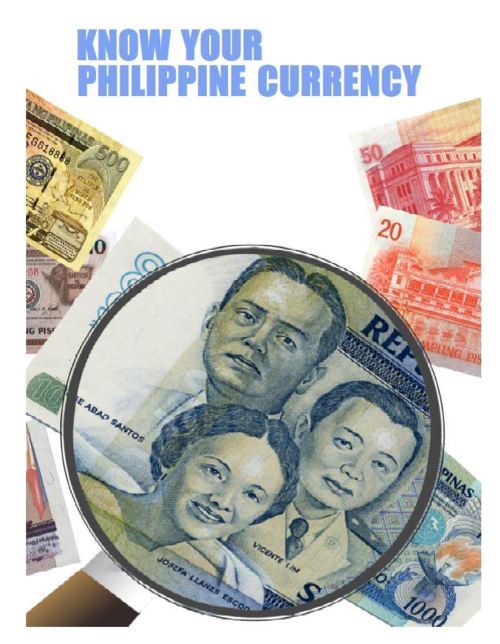Last Thursday, we had a nine-hour chat/gossiping at the city Dap-ayan and at McDonald's. It was around 9PM when we decided to continue our talk at a friend's house three kilometers away. Jeepney's weren't available that time so we resorted riding on a tricycle. Besides, there were a lot of them outside the fast-food chain. However, there was a slight commotion. But we never bothered until we finally rode our way to the nearby town.
"What happened, kuya?" asked a friend. The driver mumbled something we didn't quite comprehend. So we asked once more. Turns out that a guy or two boughtlechon manok in a nearby store and paid a counterfeit 1000-peso bill. Good thing somebody caught them.

I am disappointed that Filipinos, much more Ilocanos, use fake money just to gain, well, goods and real money (i.e. change). But I was still proud that some peopleknow how to detect such. Which leads to the point of this post: how do you recognize genuine Philippine notes? The Bangko Sentral ng Pilipinas presents 16 characteristics and features: (Note: may or may not apply to new generation bank notes)
"What happened, kuya?" asked a friend. The driver mumbled something we didn't quite comprehend. So we asked once more. Turns out that a guy or two boughtlechon manok in a nearby store and paid a counterfeit 1000-peso bill. Good thing somebody caught them.

I am disappointed that Filipinos, much more Ilocanos, use fake money just to gain, well, goods and real money (i.e. change). But I was still proud that some peopleknow how to detect such. Which leads to the point of this post: how do you recognize genuine Philippine notes? The Bangko Sentral ng Pilipinas presents 16 characteristics and features: (Note: may or may not apply to new generation bank notes)
1. PAPERBut of course, it would be very difficult if we are to check all of these characteristics and features, right? Reminds me, a friend of mine advised "Crumple the note." If it doesn't go back to its original form (i.e. it doesn't budge) easily, then it's authentic. [Pardon the description, I'm running out of words. But I hope you get it. :) ]
Philippine notes are printed in rough special paper which does not glow under ultraviolet light.
2. WATERMARK
This is present in an unprinted portion and shows the silhouette of the portrait showing on the obverse side of the note.
3. SECURITY FIBERS
These are red and blue fibers scattered all around the note.
4. EMBEDDED SECURITY THREAD
This can be easily viewed against the light. It is a vertical thread implanted in the paper. It is a broken line for 20's and a straight line for higher denominations. (Although I've noticed they are all straight lines in the new generation bank notes).
5. WINDOWED SECURITY THREAD
Present in 100's, 200's, 500's and 1000's, it's a vertical "stitch".
6. IRIDESCENT BAND
Present in 100's, 200's, 500's and 1000's, it's a vertical gold band showing the numerical value of the note.
7. PORTRAIT
I know you know this. BSP however tells us that the portrait must be "life like".
8. SERIAL NUMBER
Composed of 1 or 2 prefix letters and 6 or 7 numbers. A note with six zeros is a specimen note.
9. BACKGROUND/LACEWORK DESIGN
Background is made up of multicolored well-defined lines whilst the lacework is made up of web-crisscrossing lines where the intersection is traceable.
10. VIGNETTE
The lines and dashes composing the vignette are fine, distinct and sharp.
11. VALUE PANEL
These are the numbers present in the four corners in the obverse and reverse side of the note.
12. COLOR
1000=Blue
500=Yellow
200=Green
100=Mauve
50=Red
20=Orange
13. FLUORESCENT PRINTING
This is the invisible numerical value in the note that shows under the presence of ultraviolet light.
14. MICROPRINTING
Present in 50's and higher denominations, these are the minute printed words "Bangko Sentral ng Pilipinas" or "Central Bank of the Philippines" present in either the obverse or reverse. On the 100-peso note, this is present in the reverse side, printed as a line in front of a building.
15. CONCEALED VALUE
Present in the 500-peso note, it is a printed numerical value at the lower left corner, visible only when viewed at eye-level.
16. OPTICALLY VARIABLE INK (OVI)
Present in 1000's, it is printed at the lower left corner and changes from blue to green (or vice versa) when held at different angles.
Read more here: http://www.bsp.gov.ph/downloads/know%20your%20currency.PDF
No comments:
Post a Comment